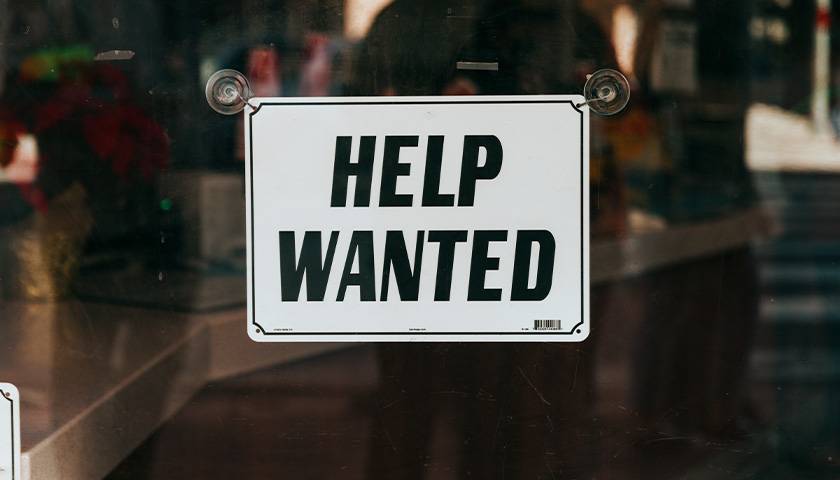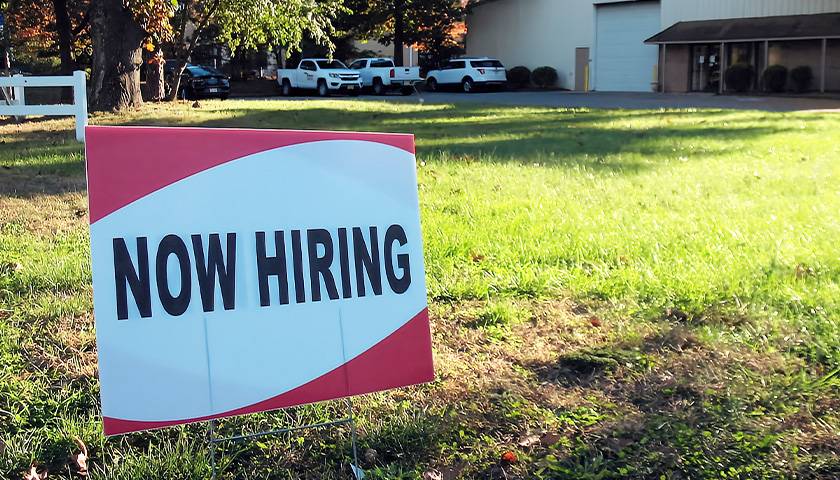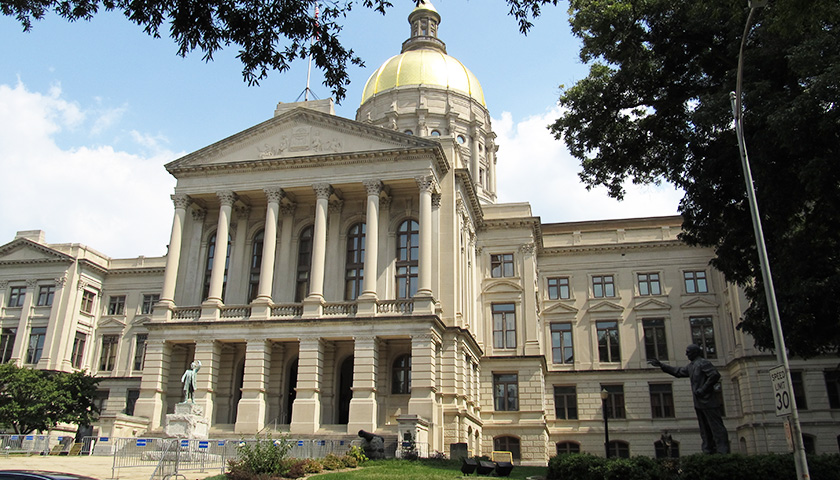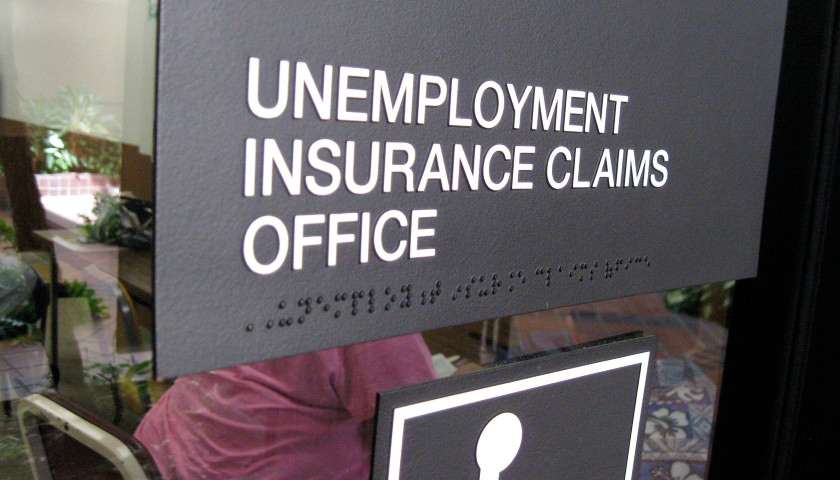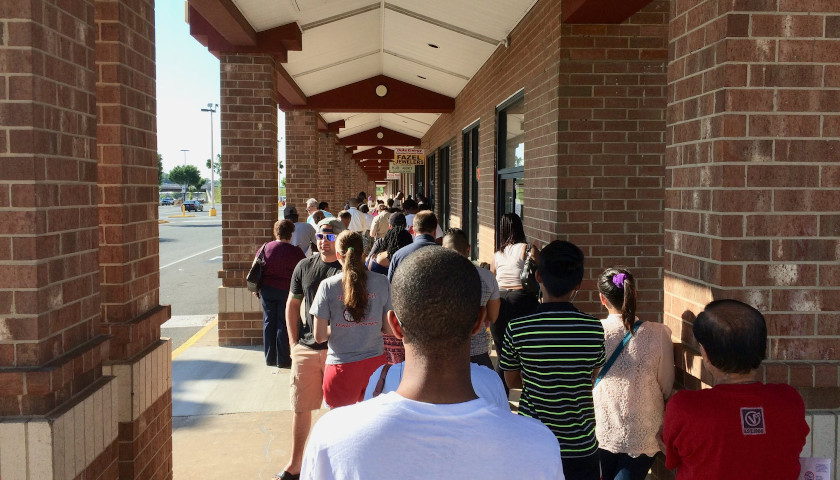The unemployment rate in the U.S. ticked upwards to 4.2 percent in November, with 161,000 additional Americans saying they are unemployed in the latest household survey by the Bureau of Labor Statistics.
Read MoreTag: unemployment rate
U.S. Economy Added 227K Jobs in November, Annual Jobless Rate Increased Slightly to 4.2 Percent: Feds
The Labor Department reported Friday the number of new jobs in the U.S. economy increased in November, compared to the previous month, while the unemployment rate increased slightly to the annualize rate of 4.2%
The economy in November added 227,000 new, non-farm jobs, compared to 36,000 in October, according to the department’s Bureau of Labor Statistics. The November number exceeded Wall Street expectations of 214,000 new jobs.
Read MoreSeptember Job Growth Exceeds Expectations as Unemployment Falls
The U.S. added 254,000 nonfarm payroll jobs in September as the unemployment rate ticked down to 4.1%, according to Bureau of Labor Statistics (BLS) data released Friday.
Economists expected 150,000 jobs to be added in September, slightly higher than the initially reported 142,000 job gain in August, and the unemployment rate to remain at 4.2%, according to MarketWatch. Meanwhile, previously reported job gains for July and August were revised up by 55,000 and 17,000, respectively, breaking a trend under the Biden-Harris administration of overestimating employment growth in initial estimates, with the cumulative number of new jobs reported in 2023 roughly 1.3 million less than previously thought.
Read MoreU.S. Job Growth Slows to a Crawl as Unemployment Rises
The U.S. added 114,000 nonfarm payroll jobs in July as the unemployment rate ticked up to 4.3%, according to Bureau of Labor Statistics (BLS) data released Friday.
Economists anticipated that the country would add 175,000 jobs in July compared to the 206,000 added in initial estimates for June, and that the unemployment rate would remain stable at 4.1%, according to U.S. News and World Report. Federal Reserve Chairman Jerome Powell noted in a press conference on Wednesday that a continued slowdown in the labor market could be a sign of further softening in the economy and contribute to a possible cut to the federal funds rate and an easing in harsh credit conditions that have weighed on Americans.
Read MoreUnemployment Rate Climbs for Another Month as Job Gains Slump
The U.S. added 206,000 nonfarm payroll jobs in June as the unemployment rate ticked up to 4.1%, according to Bureau of Labor Statistics (BLS) data released Friday.
Economists anticipated that 190,000 jobs would be added in June, far fewer than the initially reported 272,000 gain seen in May, and the unemployment rate would remain steady at 4%, according to U.S. News and World Report. Strong topline job gains in recent months have led some top economic officials, like Federal Reserve Chair Jerome Powell, to push back against claims that the economy is stalling, despite slow economic growth and high inflation.
Read MoreGeorgia Sees Slight Unemployment Rate Increase in May
Georgia’s unemployment rate increased slightly in May, hitting 3.2%, up from a revised 3.1% in April, and a leading Georgia business group said inflation is still challenging many businesses.
However, the Peach State’s unemployment rate was lower than the national unemployment rate of 4%, Georgia officials touted.
Read MoreJob Market Continues Hot Streak Despite Persistent Layoffs
The U.S. added 303,000 nonfarm payroll jobs in March as the unemployment rate ticked down to 3.8%, according to Bureau of Labor Statistics (BLS) data released Friday.
Economists anticipated that the country would add 200,000 jobs in March compared to the 275,000 jobs that were added in initial estimates for February, and that the unemployment rate would remain unchanged at 3.9%, according to Reuters. The job gains are in spite of persistent layoffs that reached a 14-month peak in March at 90,309.
Read MoreGeorgia’s Unemployment Rate Remains Flat in February
Georgia’s February unemployment rate remained unchanged from the revised January rate, labor officials said Thursday.
State officials said the Peach State’s 3.1% unemployment rate is below the national rate of 3.9%. Last week, state officials said Georgia’s January unemployment rate dropped to 3.1%, the first drop in more than a year after holding at 3.2% in 2023.
Read MoreJob Growth Exceeds Expectations Despite Mass Layoffs
The U.S. added 353,000 nonfarm payroll jobs in January as the unemployment rate remained at 3.7%, according to Bureau of Labor Statistics (BLS) data released Friday.
Economists anticipated that the country would add 180,000 jobs in January compared to the 216,000 that were added in December and that the unemployment rate would tick up to 3.8% from 3.7%, according to Reuters. Despite the job gains, American employers cut 82,307 positions in January, a 136% jump from the previous month, amid a wider trend of layoffs as factors like high inflation continue to hurt business conditions.
Read MoreJob Growth Remains Cool Despite Boost from Returning Strikers
The U.S. added 199,000 nonfarm payroll jobs in November as the unemployment rate ticked down to 3.7%, according to Bureau of Labor Statistics (BLS) data released Friday.
Economists had anticipated that the country would add 180,000 jobs in November compared to the 150,000 jobs that were added in October and that the unemployment rate would remain at 3.9%, according to Reuters. The number of jobs added in the month was boosted due to the resumption of work by autoworkers and actors who participated in the recent strikes.
Read MoreGeorgia’s October Unemployment Rate Remains Below National Average
Georgia’s seasonally adjusted October unemployment rate was 3.4 percent, the same as September’s revised rate.
The Peach State’s unemployment rate increased from the 3.1 percent rate a year ago. However, it was below the national rate of 3.9 percent.
Read MoreJob Gains Fall Short of Expectations as Unemployment Ticks Up
The U.S. added 150,000 nonfarm payroll jobs in October as the unemployment rate ticked up to 3.9%, according to Bureau of Labor Statistics (BLS) data released Friday.
Economists had anticipated that the country would add 180,000 jobs in October compared to the 336,000 jobs that were added in September and that the unemployment rate would remain at 3.8%, according to Reuters. On Wednesday, at the conclusion of its Federal Open Market Committee meeting, the Federal Reserve announced that it would be keeping its federal funds rate steady in the range of 5.25% and 5.50%, a 22-year high, after a series of 11 rate hikes that started in March 2022 in an effort to tame inflation.
Read MoreAmerica Adds over 300,000 Jobs in September as Interest Rates Remain Elevated
The U.S. added 336,000 nonfarm payroll jobs in September as the unemployment rate remained at 3.8%, according to Bureau of Labor Statistics (BLS) data released Friday.
Economists had anticipated that the country would add 170,000 jobs in September compared to 187,000 in August and that the unemployment rate would slide down to 3.7% from 3.8%, according to Reuters. Private employment data for September showed that only 89,000 jobs were added for the month, as the professional and business services, trade, transportations and utilities and manufacturing services sectors all had substantial losses, according to ADP.
Read MoreState Officials Wonder How Georgia Businesses Fill Their Open Jobs
Georgia has 350,000 job postings but only about 170,000 unemployed Georgians.
State officials routinely highlight Georgia’s low unemployment rate, but that doesn’t address the worker shortage.
Read MoreGeorgia’s Unemployment Rate Remains Below National Average
Georgia’s unemployment rate continues to remain lower than the national rate.
On Thursday, officials said the Peach State’s June rate was 3.2%, the same as May’s revised rate and lower than the national average of 3.6%.
Read MoreCommentary: As Hiring Slows Down, So Does the Economy
The U.S. economy added 209,000 jobs in June, according to the latest establishment survey by the Bureau of Labor Statistics, less than expected as 306,000 were added in May, as hiring slowed down nationwide. Meanwhile, the unemployment rate remained about the same at 3.6 percent.
Historically, when hiring slows down by establishments, that usually coincides with economic slowdowns and recessions. In the recent cycle, the 2020 and 2021 recovery from Covid notwithstanding, hiring peaked at about 5.2 percent annualized increase in Feb. 2022. Now, it’s down to 2.5 percent.
Read MoreGeorgia Committee Probes Ways to Expand State’s Workforce
Georgia has a 3.2% unemployment rate and roughly 5.1 million people in its workforce, but Peach State companies struggle to recruit employees.
And, a looming recession may only temporarily ease hiring troubles, testimony at the first meeting of the Senate Study Committee on Expanding Georgia’s Workforce revealed.
Read MoreEconomy Added 339K Jobs in May, Nearly Double Wall Street Expectations
U.S. employers have added roughly 339,000 jobs in May, and the monthly unemployment rate rose to 3.7%, from a five-decade low of 3.4% in April, according to a Labor Department report released Friday.
Average hourly earnings rose 0.3% for the month while on an annual basis, wages increased 4.3%, which was a 0.1 percentage point under the estimate.
Read MoreCommentary: Recession Looms as Banks Collapse and the Economy Slows
The unemployment rate still remains at historic lows of 3.4 percent in April, according to the latest data by the Bureau of Labor Statistics, amid other worrying signs for the U.S. economy including a continued collapse of job openings, a string of bank failure and an overall slowing Gross Domestic Product (GDP).
In the survey, as the population increased by 171,000, those not in the labor force increased by 214,000 as labor participation dipped slightly by 43,000. Those who said they had a job increased by 139,000 after a 577,000 increase in March. As a result, the unemployment rate has actually ticked downward for two consecutive months from 3.6 percent in February, to 3.5 percent in March and now 3.4 percent in April.
Read MoreGeorgia Businessman Pleads Guilty to Bribing Officials
A 72-year-old Alpharetta businessman pleaded guilty in federal court to bribing two Atlanta city officials in exchange for steering millions of dollars of city business to his company.
Read MoreGeorgia Unemployment Rate Remains Low for Seventh Consecutive Month
For the seventh straight month, Georgia’s unemployment rate remained at 3.1%, 0.5% below the national average in February.
The Georgia Department of Labor says the Peach State in January had the highest labor force participation rate in the Southeast at 61% and also had the highest employment-to-population ratio in the region, 59.1%.
Read MoreGeorgia Unemployment Rate Increases in January
Georgia’s regional commissions reported higher unemployment in January but the labor force grew in all but one of the state’s regions, according to numbers released on Thursday.
The Georgia Department of Labor says it is an annual trend for unadjusted unemployment rates to increase in January after the end of the holiday season.
Read MoreU.S. Economy Adds 517,000 Jobs as Unemployment Drops to Lowest Since 1969
The U.S. economy added 517,000 jobs in January as the unemployment rate dropped to 3.4%, the lowest since May 1969.
By comparison, there were 260,000 jobs added in December 2022 and the 517,000 was the largest increase since 568,000 in July 2022, according to the latest report from the U.S. Bureau of Labor Statistics.
Read MoreGeorgia’s Unemployment Rate Was Unchanged to Close Out 2022
Georgia’s December unemployment rate was 3%, unchanged from November’s revised rate.
Additionally, state officials said job numbers increased by nearly 6,000 from November, hitting an all-time high. Georgia’s unemployment rate remained lower than the national unemployment rate of 3.5% in December.
Read MoreGeorgia Officials Tout Unemployment Rate That Is Lower than National Average
Georgia officials said Thursday the state’s October unemployment rate remained lower than the national rate, news that follows a new finding that nearly half a million Georgians have dropped out of the workforce.
While Georgia’s seasonally adjusted unemployment rate of 2.9% was lower than the national unemployment rate of 3.7%, it was slightly higher than last month’s rate of 2.8% but down from last October’s 3.4% rate.
Read MoreUnemployment Rate Rose in October
Newly released federal data show the economy created more jobs than expected but unemployment rose in October.
The U.S. Bureau of Labor Statistics released the data, which showed the economy added 261,000 jobs in October, higher than the Dow Jones estimate of 205,000 new jobs.
Read MoreReport: Georgia Has One of the Nation’s Best Improvements in Its Unemployment Rate
Georgia reported one of the best changes in its unemployment rate of any state in the union, a new analysis found.
According to the report from WalletHub, Georgia has the 15th best change in unemployment. That trailed neighboring Florida (No. 6) and Alabama (12) but was better than South Carolina (28), Tennessee (32) and North Carolina (35).
Read MoreNew Economic Data Shows That Georgia Is Outperforming Many States
New economic data shows Georgia is outperforming many other states across the country.
Georgia’s seasonally adjusted unemployment rate now stands at a record low of 2.8% in July. A new WalletHub analysis found that Georgia has the 15th best change in its unemployment rate
Read MoreGeorgia Unemployment Rate at Record Low
Georgia Department of Labor Commissioner Mark Butler announced on Thursday that the unemployment rate for the Peach State in May dipped to an all-time low of three percent as the number of jobs peaked at 4,782,400.
“As the state continues to experience a very tight labor market, as evidenced by our low unemployment rate, our focus has been on encouraging more individuals to re-enter the workforce,” Butler said. “Unless those who have chosen not work decide they want to re-enter the workforce or more people move into the state, additional workers will be scarce.”
Read MoreGeorgia Policy Group Warns That State’s Labor Force Participation Rate Lags Behind Other States
While state officials touted their recent unemployment numbers as an all-time record, a state organization says a deeper analysis of the numbers shows a troubling undercurrent.
Georgia’s unemployment rate in March dropped to an all-time low of 3.1%, down from February’s revised rate of 3.2%, as the number of employed Georgians also hit a record high. Georgia is tied with Arkansas for the 16th lowest unemployment rate, according to an analysis from the Georgia Center for Opportunity (GCO).
Read MoreThe U.S. Has Nearly Recovered All the Jobs Lost to COVID Lockdowns
The U.S. economy recorded an increase of 431,000 jobs in March as COVID-19 concerns ease and more Americans seek work to combat the surging cost of living.
Total nonfarm payroll employment increased by 431,000 in March while the unemployment rate dipped to 3.6%, according to the Bureau of Labor Statistics (BLS). Economists surveyed by Dow Jones predicted the U.S. economy would add 490,000 jobs.
Read MoreCommentary: The Unemployment Rate Does Not Offer Guidance Now
The Labor Department’s official unemployment rate—the most well-known gauge of the labor market’s health—counts as unemployed only those who aren’t working but are actively seeking a job.
Yet there is very little that we can infer from the jobless rate about the health of the economy. The unavoidable conclusion is that the only reason investors follow the calculation is because both Washington’s politicians and the Federal Reserve are expected to react to it.
Read MoreU.S. Economy Added 194,000 Jobs in September, Badly Missing Expectations
The U.S. economy reported an increase of 194,000 jobs in September, and the unemployment rate fell to 4.8%, according to Department of Labor statistics.
The number of unemployed people fell by 710,000 to 7.7 million, according to the Department of Labor statistics released Friday. Economists projected that employers created 500,000f jobs in September, more than double the figure in August, according to the Wall Street Journal.
Despite the spike in employment, the labor market remains thin due to the pandemic, and job growth earlier in the year was considerably stronger, according to the WSJ.
Read MoreLocales Across Georgia See Good Employment News; Big-Government and Union-Friendly States Less Well-Off
Georgia has a lower percentage of unemployed residents now than it did immediately before COVID-19 arrived, with some locales, like Warner Robins, experiencing their lowest jobless rates ever.
In Sept. 2020, around six months after the pandemic hit, the small city just south of Macon had a 5.3-percent jobless rate. Two months ago, Warner Robins’s rate fell to 2.9 percent, the city never before having seen such a small fraction of its residents out of work.
Read MoreU.S. Added 379,000 Jobs in February, Unemployment Rate Fell to 6.2 Percent
The U.S. economy reported an increase of 379,000 jobs in February while the unemployment rate fell to 6.2%, according to Department of Labor data released Friday.
Total non-farm payroll employment increased by 379,000 in February, according to the Bureau of Labor Statistics (BLS) report, and the number of unemployed persons fell slightly to 10 million. Economists projected 210,000 Americans to be added to payrolls and the unemployment rate to increase to hold at 6.3% prior to Friday’s report, according to The Wall Street Journal.
Read MoreU.S. Added 49,000 Jobs in January, Unemployment Rate Fell to 6.3 Percent
The U.S. economy reported an increase of 49,000 jobs in January while the unemployment rate fell to 6.3%, according to Department of Labor data released Friday.
Total non-farm payroll employment increased by 49,000 in January, according to the Bureau of Labor Statistics report, and the number of unemployed persons fell to 10.1 million. Economists projected 50,000 Americans to be added to payrolls and the unemployment rate to increase to come in at 6.7% prior to Friday’s report, according to the WSJ.
Read MoreNew Jobless Claims Decrease to 779,000, Economists Expected 830,000
The number of Americans filing new unemployment claims decreased to 779,000 last week as the economy continued to suffer the effects of the ongoing coronavirus pandemic, according to the Department of Labor.
The Bureau of Labor and Statistics (BLS) figure released Thursday represented a decrease in the number of new jobless claims compared to the week ending Jan. 23, in which there were 847,000 new jobless claims reported. Roughly 17.8 million Americans continue to collect unemployment benefits, according to the BLS report Thursday.
Read MoreNew Jobless Claims Spike to 965,000, Economists Expected 800,000
The number of Americans filing new unemployment claims increased to 965,000 last week as the economy continued to suffer the effects of the ongoing coronavirus pandemic, according to the Department of Labor.
The Bureau of Labor and Statistics (BLS) figure released Thursday represented a increase in the number of new jobless claims compared to the week ending Jan. 9, in which there were 787,000 new jobless claims reported. Roughly 18.4 million Americans continue to collect unemployment benefits, according to the BLS report Thursday.
Read MoreNew Unemployment Claims Decrease to 712,000, Beating Expectations
The number of Americans filing new unemployment claims decreased to 712,000 last week as the economy continued to suffer the effects of the ongoing coronavirus pandemic, according to the Department of Labor.
The Bureau of Labor and Statistics (BLS) figure released Thursday represented a decrease of new jobless claims compared to the week ending Nov. 21, in which there were 778,000 new jobless claims reported. New jobless claims have stayed below 800,000 for more than a month.
Read MoreNew Unemployment Claims Increase to 778,000, Missing Expectations
The number of Americans filing new unemployment claims increased to 778,000 last week as the economy continued to suffer the effects of the ongoing coronavirus pandemic, according to the Department of Labor.
The Bureau of Labor and Statistics (BLS) figure released Wednesday represented an increase of new jobless claims compared to the week ending Nov. 14, in which there were 742,000 new jobless claims reported. New jobless claims have stayed below 800,000 for more than a month.
Read MoreAs Jobless Claims Increase, Some States Employment Rates Are Bouncing Back
The number of individuals who filed for unemployment benefits last week increased to 742,000, the first increase in five weeks, according to new data published by the U.S. Department of Labor.
The number of people who filed for state unemployment benefits in the week ending Nov. 13 grew by 31,000 from the previous week’s revised level of 711,000, according to the Nov. 19 report.
Read MoreNew Unemployment Claims Increase to 742,000, Missing Expectations
The number of Americans filing new unemployment claims increased to 742,000 last week as the economy continued to suffer the effects of the ongoing coronavirus pandemic, according to the Department of Labor.
The Bureau of Labor and Statistics (BLS) figure released Thursday represented an increase of new jobless claims compared to the week ending Nov. 7, in which there were 709,000 new jobless claims reported. New jobless claims have been below 800,000 for five consecutive weeks.
Read MoreNew Unemployment Claims Miss Expectations, Stay Unchanged
The number of Americans filing new unemployment claims came in at 751,000 last week as the economy continues to suffer the effects of the ongoing coronavirus pandemic, according to the Department of Labor.
New jobless claims were unchanged compared to the week ending Oct. 24 in which there were also 751,000 new jobless claims reported, the Bureau of Labor and Statistics figure released Thursday showed. New jobless claims have been below 800,000 for three consecutive weeks, according to CNBC.
Read MoreNew Unemployment Claims Decrease to 837,000, Beat Expectations
The number of Americans filing new unemployment claims decreased to 837,000 last week as the economy continues to suffer the effects of the ongoing coronavirus pandemic, according to the Department of Labor.
The Department of Labor figure released Thursday represented a decrease of new jobless claims compared to the week ending on Sept. 19, in which there were 870,000 new jobless claims reported.
Read More




















